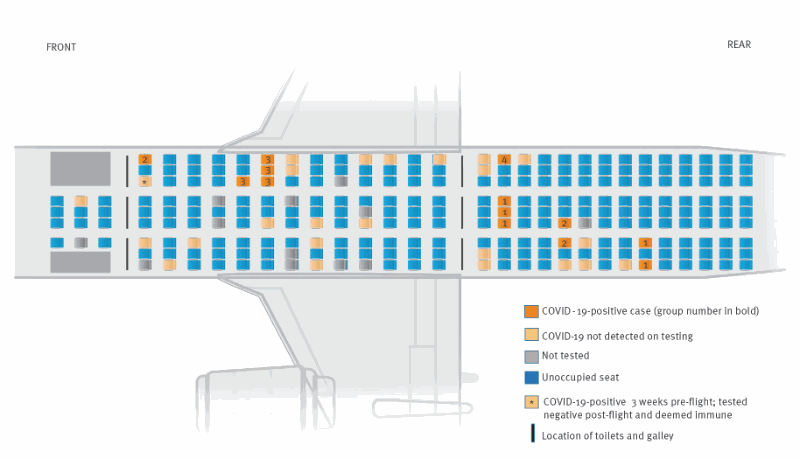Over a billion people have flown so far in 2020. Flying seems to be incredibly safe in the Covid era. There are flights where virus transmission is believed to have occurred, but it’s very few. Sure, contact tracing may be limited. At the same time no illness has been so carefully studied so quickly. HEPA air filters, regular refresh of cabin air, and air flown downwards seem to prevent most potential spread.
When there are cases of possible virus spread during travel it’s often not clear whether the spread happened on the plane – or in airport. That matters because it could focus on the right protective measures to take to reduce spread even further. While planes themselves, inflight or with their auxiliary power on, may be one of the safest indoor areas (certainly compared to restaurants, gyms, theaters) airports are indoors too.
There’s a new flight identified as a possible source of virus spread and it’s being touted in scary terms, linking it “to 59 infections” though that’s not quite what you think it is.
A Qatar Airways flight from Doha to Dublin had 13 people on board test positive for the virus, and tracing linked those cases to further spread which gets to the 59 figure.

It isn’t surprising that there were several people with the virus on a Qatar flight. Gulf carriers have brought numerous Covid-positive passengers from South Asia around the world, and the nation of Qatar itself has among the highest per capita reported infection rates in the world. (This has largely been confined to its migrant worker population.)
Passengers on the flight with the virus weren’t sitting near each other. Most of the passengers were reportedly masked. However it’s not clear when each person became infected,
One group of cases reported spending up to 12 hours overnight in the transit lounge during stopover; another shared a separate transit lounge; while two other groups had separate short waits of under two hours in the general airport departure area.
Genome sequencing was done on only 5 samples showing that the viruses were linked. Even that doesn’t show the infections happened on the plane. The paper acknowledges the possibility of spread from close household contact, as well as “during overnight transfer/pre-flight or unknown acquisition before the flight.” Yet the study concludes it “is one of few thus far demonstrating in-flight transmission of SARS-CoV-2 with extensive onwards transmission.” Except it hasn’t demonstrated that at all. Doing so is hard.
While inflight transmission seems to be rare, it certainly isn’t impossible, and someone with a high viral load and lots of shedding may overcome the best precautions. The virus might spread at security, in a lounge, at the gate area, or simply transiting the terminal. It could spread on the jetway as well. Flying is safe, but not totally safe. In many ways, just like going to the grocery store.


Flying is like going to the grocery store? Don’t recall PUBIX ever belting me in a seat next to other shoppers taking off their masks to drink and eat their can of Pringles. Think I’ll fly wait for the vaccine.
IDK bro. Sounds bad. Do you really wanna tell your grandkids that you sold credit card miles during a once in a century pandemic? Is that your legacy? Look in a mirror.
Every time I read one of these “flying is safe because of HEPA filters” blog posts, I think of all the risks that occur when the aircraft is not flying: at security, in the gate area, when boarding the aircraft, and when disembarking. HEPA filters aren’t there in those situations.
.Flying is like going to the grocery store? Okay, but what about the hepa filters? Can we get a coiuple of those in the produce section??
One would think that if flying was a risk flight attendants would be coming down with the virus.
Of course, that could be happening, and no one – neither that airlines nor the flight attendant unions – have an interest in publicizing that information.
This study is important, because it’s one of the few actual investigations of the issue. Now, in this case, we learn that 80% of the passengers could be contacted.
Here’s a study for you: take blood samples at the gate and two weeks later for flights on three similar routes, say ORD-LAX, ORD-SFO, and ORD-SEA. Do PCR and antigen testing. Group those data with age, sex, seat.
What does the distribution of developed cases look like? Are you seeing infection in airports, airplanes, or at destination/origin, and at what level compared to the general population?
Of course, I doubt any airline will want to participate in such a test, let alone fund it: if the results aren’t ideal, then they would be knowingly making people sick. So better to cook up some “tests” that give the “correct” results.
And so we get industry garbage simulations and medical contract tracing anecdotes. Neither tells us much, other than transmission via air travel most certainly occurs, and the risk is non-zero.
@stvr – he’s kept up this “informed skeptic” thing for several months. He’s got incentive to continue.
Article from WaPo in early September summed up the situation best. From the CDC spokeswoman: “An absence of cases identified or reported is not evidence that there were no cases.”
Each time I fly now – all seats are occupied. How is it that that plane was so empty of people? (Im color blind but I think I see the blue colored seats are all unoccupied.)